
In this article we are going to show how to copy the painting “Lotus Out of Water“.
This is an easy exercise for beginners – no previous training in Chinese painting is needed.
(Please note that we might not strictly adhere to the Chinese Gongbi painting rules, because this tutorial aims to make it easy for anyone to enjoy the beauty of this painting as a hobby. )
Lotus Out of Water – a masterpiece from Song Dynasty

“Lotus Out of Water” was painted by artist Wu Bing in the Song Dynasty. Painted on silk, this painting is 23.8 cm high and 25.1 cm wide. It is from one of the most famous collections in the Forbidden City in Beijing. In Song Dynasty, detailed Gong Bi Hua painting style was greatly developed and reached its peak in Chinese history. One important reason for this is that the emperors of Song Dynasty were all very fond of detailed paintings. If you check the history of Song Dynasty, you would find it is very interesting that almost all the very high level officials, even the emperors themselves, were experts on Chinese paintings, especially detailed painting, which is also called in Chinese Gong Bi Hua (工笔画), in English Gongbi painting since we have no direct English translation for Gongbi.
This Lotus Out of Water is definitely one of the best paintings of flowers from the whole Song Dynasty. The painting is very elegant, simple, humble but it still gives you a very complex feeling that the painting or the lotus flower in this painting is extremely luxurious. So, you feel both low profile and high profile hidden behind the painting. This is very special. Besides this, although there is only one lotus flowering in this small size painting, you have the sensation that this lotus and the lotus leaves are being blown by the summer breeze. Speaking of the techniques used by the artist, all the strokes are very light. You can feel the very complicated changes of colours from white to pink to red. It seems the artist has applied many layers of inks on the painting. However, you feel the painting is still very ‘light’ instead of being a painting wearing many heavy masks.
The techniques used for the lotus petals look very similar to the freehand skills which were not well developed until many years later in history. These skills mean it is not possible to discern the individual strokes in the painting so that the flower and leaves in this painting both come out as natural as those in a photo. This is the opposite of the “Bone method” painting which is based on calligraphy.
If you observe even closer, you also notice that the artist actually paid so much attention to details such as yellowish pollen hidden in petals, blackish dots on top of the lotus seeds and these black dots might be caused by the sunshine at lunch time, etc. The angles and shapes of the petals just make you feel this is not a painting but a window through which you can see a lotus growing in the middle of a lake and you can feel the breeze is blowing the lotus.
In the following part of the article, we are going to show you how to make your own copy of this flower.
Materials Needed

- Mineral Color Ink Sticks,
- Black Yellow Mountain Pine Tree Oil Ink Stick,
- Water cup,
- Inkstone,
- Framed Golden “cooked” Shu Xuan Paper or plain Shu Xuan Paper, (you can also try Mica Shimmer Handmade Shu Xuan Paper.)
- Ballpoint Pen,
- Pencil,
- Gong Bi Hua brushes,
- Brush rest,
- Lotus Sketch (you can find some nice Gongbi painting sketches in these books: Grass and Insects, Flowers).
Inkston has a complete Gongbi Materials Kit and it meets all the needs for Gongbi paintings.
For ink sticks, we like using ink sticks produced by the Old Hu Kai Wen ink factory, which as the most prestigious and oldest ink factory in China, is still producing these ink sticks with the thousands year old traditional recipe. (Old Hu Kai Wen set of 12 Mineral Colour Ink Sticks)
Step One: Make Sketch
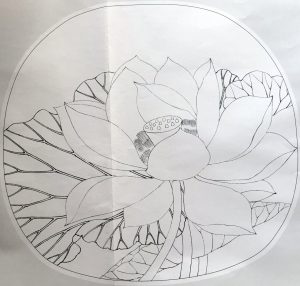
First of all, you can draw the lotus sketch with pencil directly on the Shu Xuan Paper. (You can also try Mica Shimmer Handmade Shu Xuan Paper).
Be careful to get it right, please don’t use an eraser to correct mistakes on the Shu Xuan Paper because this might destroy the golden surface.
If you are not confident about doing this successfully first time, you can also do it another way.
- Place the printed lotus sketch on top of the golden shu Xuan Paper.
- Then use the ball pen to trace over the printed sketch in order to leave an imprint of the lotus on the Shu Xuan Paper.
By using this method you can transfer an outline of the lotus onto the thick framed Xuan Paper.
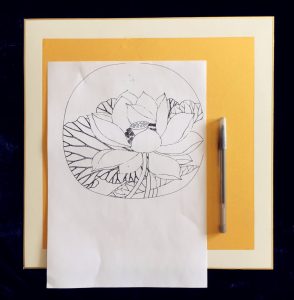


Next, use the pencil to draw the lotus on the framed Golden Shu Xuan Paper. Because there is already an impression left by the tracing, now you only need to use pencil to make the marks clearer for the next stage.

You can refer to the video clip for how to do this step:
Step Two: prepare brushes and inks
After finishing the lotus sketch, we can prepare brushes and colours for the painting.

Firstly, prepare three Gong Bi Hua brushes. There are different kinds of brushes for different purposes. Normally Gong Bi Hua brushes are much smaller than other brushes. There is no strict rules on use of these brushes. For me, the most important thing is that you choose the one your hands feel comfortable to master and paint. Usually, the three kinds of Gong Bi Hua brushes shown in the photo below would be the most useful to cover almost all the needs for a nice Gong Bi Hua painting. For this lotus painting, we also choose to use this set.

When the brushes are not used, their hairs are dry and, therefore, not suitable to use directly with ink to paint. Hence, you need to make them damp. This step is very easy. You just need to fill the water cup with clean water, rinse the brushes in the water, then take them out to dry off excess water. Remember to keep the brush hair in good shape. You can refer to the photos below.

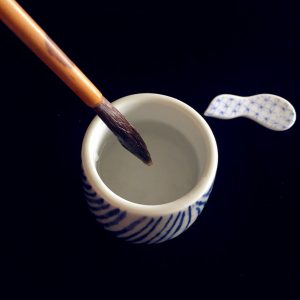
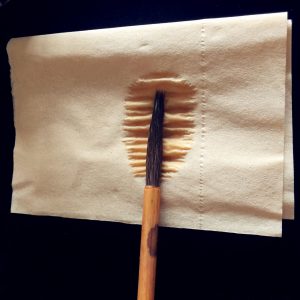

Next, we can start to prepare the inks. By observing the Lotus painting, it is easy to see that the major colours needed for this painting are red, white, green, yellow, and black. Therefore, take out these colours from the ink stick box. We recommend to use the traditional Chinese mineral colour ink sticks. These colours are extracted from rocks and have very bright and natural effects which do not fade. For the black ink, we use Old Hu Kai Wen pine tree oil ink stick, which is famous for its wonderful effects on Chinese painting and it is also very economical compared with Hu Kai Wen lamp rock oil ink stick.

Old Hu Kai Wen ink sticks can produce colour very quickly and the colour is very thick and smooth. This Lotus Painting is very light and has to be painted with many layers. Therefore, we can simply add more water into the inks to make the inks very light and transparent. The colour we will use most for this painting is white, then it is red; the yellow, green, and black will not be used till the very last step. Considering this, we will first prepare the white inks. The most interesting part of ink preparation is to create pink colours. There are different pinks in the lotus, therefore, the simple way is to start painting white, then add little red into white, every time you add extra red into the ink. By doing this, every time, the pink is getting more red. There is no strict rule for you to follow. You only need to understand the change of colours and add your own understanding and feeling into your painting. By doing this, you will have a lotus flower of your own style. Have your own personality and style in the painting is a very interesting and exciting experience. (Old Hu Kai Wen She Ink Stone)
See the videos for this step:
Step Three: Paint the Lotus
First and foremost, it is very important to draw the petals one by one respectively to avoid the water colours of the different petals get mixed together. It is advisable to draw petals which are not next to each other and do not start painting the middle petals until the neighbouring petals are dry. By doing this, you can make sure that different colours will be blended only on the same petal. Then, the petal can come out very natural and beautiful.
Besides this, you also need to keep changing the thickness and white and pink colours in order to create the colour changes. You have to observe how the colour changes on a lotus and then apply this to your own painting. This is very flexible, interesting and creative.
For this step you can refer to the video clip below:
Step Four: improve the details
Lastly, you can use the green, yellow, white, and black colours to improve the details of the painting. For this step, you can refer to the video clip below:
Now, you have completed your own Lotus Flower Painting. Do you like it?
The framed Golden Shu Xuan Paper is ready to hang on the wall now.
Hope you enjoy it!
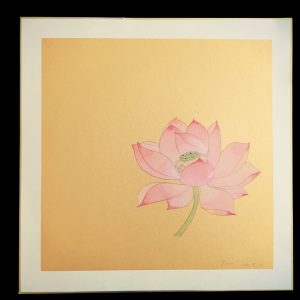
Finished Lotus paintings by 朱晓 Zhu Xiao
Here are some finished Lotus examples by award winning young chinese artist 朱晓 Zhu Xiao who also has a produced a book of her Lotus paintings. Hopefully you can see quite clearly some of the techniques discussed in this article, for example in the first painting.




[…] Here is a set of examples for reference along with sketch templates. You can use these sketches to make your own paintings as shown in: How to Paint Gong Bi Hua for beginners. […]
[…] in some nice photo gallery scripts on our oriental arts site inkston.com for example this one on How to Paint GongbiHua (also available in Spanish). In this and similar articles, you can click on any picture in that […]
[…] Huang Guohong is a representative of the Xin’an school of painting which originated here and started learning GongBi painting at the age of 6. You can also read more about GongBi painting here. […]
[…] range of Xuan papers mounted on card as featured in “How to paint Gongbi style: Lotus Out of Water“. These include gold and white papers, cut into square, circle or traditional fan shape and […]
[…] range of Xuan papers mounted on card as featured in “How to paint Gongbi style: Lotus Out of Water“. These include papers with gold, red white and other colours and designs, cut into square, […]
[…] gamme de papiers Xuan montés sur la carte dans la rubrique «Comment peindre le style Gongbi: lotus hors de l’eau». Ceux-ci incluent les livres d’or et blancs, coupés en forme de carré, en cercle ou de […]
[…] Voici un ensemble d’exemples de référence ainsi que des modèles d’esquisse. Vous pouvez utiliser ces croquis pour faire vos propres peintures comme indiqué dans: How to Paint Gong Bi Hua for beginners. […]
[…] Auswahl von Papieren, die auf Karton aufgezogen sind, wie in der ‚How to paint Gongbi style: Lotus Out of Water‘ dargestellt. Zu dieser Auswahl gehören auch goldfarbene und weiße Papiere, die zu Quadraten, […]
[…] our first article How to Paint Gongbi Style: Lotus Out of Water, we have received quite a few queries on Gongbi painting. These queries include how to choose […]
[…] notre premier article Comment peindre le style Gongbi: Lotus hors de l’eau, nous avons reçu quelques questions sur la peinture Gongbi. Ces questions comprennent comment […]